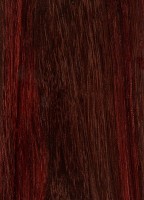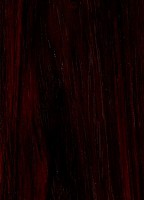 |
Common Name(s): Zitan, Red Sandalwood, Red Sanders Scientific Name: Pterocarpus santalinus Distribution: Southeastern India Tree Size: 30-50 ft (9-15 m) tall, 2-3 ft (.6-1 m) trunk diameter Average Dried Weight: 63 lbs/ft3 (1,010 kg/m3) Specific Gravity (Basic, 12% MC): .88, 1.01 Janka Hardness: 2,940 lbf (13,080 N) Modulus of Rupture: No data available Elastic Modulus: No data available Crushing Strength: No data available Shrinkage: No data available |
Color/Appearance: Heartwood ranges from a dark orange to a deeper reddish purple, often with darker streaks throughout. Colors tend to darken significantly over time to deep reddish purple to nearly black. Overall appearance and color can be very similar to Bois de Rose. Pale white sapwood is narrow, and is clearly demarcated from the heartwood. Sometimes seen with a wavy, interlocked grain figure.
Grain/Texture: Grain is generally straight or slightly interlocked. With a medium uniform texture and high natural luster.
Endgrain: Diffuse-porous; solitary and radial multiples; large to very large pores in no specific arrangement, very few; orangish brown deposits occasionally present; parenchyma winged, confluent, and banded; narrow rays, spacing fairly close to close.
Rot Resistance: No data available.
Workability: No data available.
Odor: Have a distinct, pleasing odor when being worked.
Allergies/Toxicity: Although severe reactions are quite uncommon, Zitan has been reported as an irritant; most common reactions simply include eye irritation, as well as vomiting. See the articles Wood Allergies and Toxicity and Wood Dust Safety for more information.
Pricing/Availability: Imported and used almost exclusively within China, where it commands absolutely exorbitant prices: demand for Zitan puts it into an entirely separate price tier than even the most precious hardwoods sold throughout the Western world. Despite tight trading restrictions, the wood continues to be illegally smuggled into China. Plantation sources are currently in development, but buyers should be aware of counterfeit Zitan—typically found in the form of other Pterocarpus species or a Dalbergia species (such as Bois de Rose).
Sustainability: This wood species is in CITES Appendix II, and is on the IUCN Red List. It is listed as endangered due to a population reduction of over 50% in the past three generations, caused by a decline in its natural range, and exploitation.
Common Uses: Fine furniture and carvings.
Comments: Although the tree is reported to have a very slow growth rate, plantation trees have been shown to have vigorous growth. R.H. Beddome reports in his 1869 Flora Sylvatica for South India that a 5-year old tree had already grown to a size of over 18 feet high (5.6 m) with a 9 inch (23 cm) diameter trunk. Another instance—published in World of Wood 68, no. 2 (2015): 5—reported of plantation trees that had grown to over 80 feet tall (25 m) with massive 23 inch (57 cm) trunk diameters in just 45 years.
The mystique surrounding Zitan has—very unfortunately—reached an atrocious level. Prices for the wood are so high within China, illegal smugglers are willing to take up arms and kill or be killed in attempts to obtain this wood.
Scans/Pictures: There are currently no pictures of this exact wood species, but a similar species is being substituted (Dalbergia maritima). If you’d like to contribute (or even lend) a wood sample of this specific species to be scanned, please use the contact form.






Hello this wood grows in my area and it is quite interesting economically (and from a woodworkers perspective). There is a lot of smuggling of pterocarpus santalinus into china because CITES has banned the international trade in this species but the logs that are smuggled are often plantation grown. The reason for this is that as cites banned it India only exports a small amount every year but the plantation farmers/growers produce more than they can export. So to make a profit off this wood they are forced to sell it locally (low profit but within the law which makes… Read more »
Historically wood identification in China is ideological; same species can have different names and different species can be the same name—which does not easily correlate with English names or western taxonomy. And that’s just one factor.
Pterocarpus santalinus is Zitan though Zitan is not always Pterocarpus santalinus.
Just wanted to add to the discussion the reason that zitan has such rediculous demand in china. It was cut to extinction in china for fine furniture during the ming dynasty (about five hundred years ago). The famous chinese technique of layering red and black shellac laquer is mainly meant to imitate its look, and it has only become in greater demand over time. So to everyone wondering if you have chinese zitan furniture, it is very unlikely if not at least five hundred years old, although still possible with the smuggling from india. Those who do have it, just… Read more »
Is zitan sourced from dalbergia, India?
I purchased at auction a small oriental table that is purported to be of zitan. All I know now is that it is very heavy. I plan on resawing the piece for using the wood for projects. If it is representative of zitan, I’ll let you know.
Pics would be nice, even of the table itself.
I have a small 19c antique Lotus shaped brush washer from an estate. Very Dense wood, almost black with age. It sinks in water like a rock.
Beautiful wood, was lucky enough to get a piece. I have to add that the sent is quite strong, noticeable without being working on it. And it has really fine pores that looks like white strings under light.
More images
Images? Are they showing up
Bought a house-LOVED the table the previous owners had…when looking for a picture frame to match the wood came across that it “could” be zitan…
Its a large table with 6 chairs. Inlayed mother of pearl on all chairs.
Here is what I do know…it came from China and was shipped over here and that was very expensive….we know very little about the table but I loved it. Any help would be awesome
Funny enough, I’ve obtained this exact model table yesterday for free! Definitely in rough shape however, I immediately picked it up because I knew right away that it was Dalbergia Odorifera (Huanghuali). The table design derives from the Ming dynasty. Screws were utilized somewhat. Hard to say when it was made. Mostly all Joinery though. Aside from Zitan, Huanghuali is highly prized as well. It’s very likely that you have Hainan Island Huanghuali wood and that is very special! The photos are pics from the listing I came across. Also, the long wood runners to extend the table is likely… Read more »
I have some Zitan boards I purchased from a furniture builder near Suzhou around 2003. They are about 3″ x 12″ x 30″. I simply brought them home in my luggage…..it was easy during that time. Is it now illegal to sell the wood and items I have made or may make in the future?
It wouldn’t be illegal to sell them, it’s just that they wouldn’t really be able to leave the country. CITES comes into effect when crossing international borders.
I’m guessing that the value of the raw lumber is ‘what the market will bear’, but have not seen any of the wood for sale, other than pen blank size or that which is in the format of furniture or carved objects shipping from China primarily.
Hello Jim, it’s been a while since this post, but I was wondering if you have pictures of your boards. I don’t see many examples of this wood in it’s more raw form, always finished products with high price tags. I remember seeing it in China town when I was young, usually as carved objects like dragons. Like another site user here, I am now interested in using it for the fingerboard of a guitar neck. I was able to find Bois De Rose, it’s scarce but still can be found. When looking for this wood I often only come… Read more »
can this tree be used on guitars? maybe an alternative to rosewood or ebony?
Shame it’s so rare, as it seems like a beautiful wood. I actually tried browsing for some. I would have to pay hundreds for an auction piece and butcher it. Maybe some day.
Hello
i have what i believe to be a Zitan cabinet that is about 6 feet tall
how can i find out for sure it is in fact Zitan?
What makes you think that it is Zitan? Where did the cabinet come from?
hI ERIC i THINK i HAVE A VERY INTRICATE CARVED CHAIRS, 19TH CENTURY THAT IS MMDE OUT OF ZITAN WOOD. iF IT HELP i CAN SEND YOU A PIC
Where are you located, and where did the chairs come from? If they truly are zitan, they’d be quite valuable, in which case you’d definitely not want to just rely on internet pictures, and instead get it appraised in person.
Can you sent a closeup photo of wood grain to me, I think I can identify it.
Picked up the horse saddle from Mongolia as I’m oiling it. These wonderful lines came out
could this be zitan?
Smell it.. it has minty soothing odors like minty woody plus it has lines. The lesser exposure to air is lighter and more over exposed it get darker like dark brown or almost blackish . But if it’s open to so long it might a little to none. It’s very stretchy strong on pressure! It won’t crack or chip unless u use a sharp knife!
It being a sandal wood will be obvious the shavings smell really nice like sandal wood incense , ive made a few pens from this wood and saved the shavings they smell so good
False. Zitan has no fragrance of sandalwood (santal spp).
zitan smells good. ask any chinese person.
Absolutely smells great, especially when it is heated slightly as when sanding or power carving it. My lumber came directly from a furniture building shop on the outskirts of Suzhou my Chinese friends took me to back in 2003-4, so there is no doubt of it’s authenticity. A bit of a spicy scent mixed in.
Is it simmilar wood? the one I’ve got is etremely hard, nothing like oak, It was vibrating when trying to plane it, was jumping from the planer, toughest wood I’ve seen , extremely heavy also, endgrain is very porous looking, splintering a lot and splinters are very sharp and hard.
That’s difficult to see because of the glare but it kind of looks like bubinga. Look that up on this site and see if it seems like a match.
Very hard